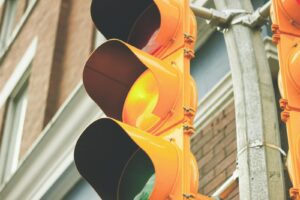The future of traffic control: Red, green, amber and white?
Adding a fourth light to traffic signals – in addition to red, green and amber – would shorten wait times at street corners for pedestrians, as well as improve traffic flow according to engineers in America. Although we’ll need more automated vehicles on the road first…
Last year, having run computational simulations, transportation engineers at North Carolina State University claimed that adding a white light to the three we are used to, would improve travel time through intersections and reduce fuel consumption. These benefits would increase as more automated vehicles took to the road.
The team have now developed that work and studied the effect this would have on pedestrians.
Ali Hajbabaie, an associate professor of civil, construction and environmental engineering at the University said: ‘Our earlier work introduced the idea of a fourth traffic signal called a ‘white phase,’ which taps into the computing power of autonomous vehicles (AVs) in order to expedite traffic at intersections – but we had not yet incorporated what this concept would mean for pedestrians. We’ve now expanded our computational modeling to account for foot traffic, and the results are extremely promising for both pedestrians and vehicles.’
The concept is based on the fact that AVs can communicate wirelessly with other vehicles and the computer controlling the traffic signal. When enough AVs are approaching the intersection, this would activate the white light. The white light is a signal that AVs are coordinating their movement to facilitate traffic through the intersection more efficiently. Any non-automated vehicles – those being driven by a person – would simply be required to follow the vehicle in front of them: if the car in front of them stops, they stop; if the car in front of them goes through the intersection, they go through the intersection.
When too many vehicles approaching the intersection are being controlled by drivers, rather than AVs, the traffic light would revert to the conventional green-yellow-red signal pattern.
The new research has added pedestrians into the mix and found that the white phase concept improves efficiency for everyone.
Hajbabaie says: ‘If at some point in the future we see almost universal adoption of AVs, our models suggest that delays at intersections would decrease by more than 25%. More realistically, we will eventually see a lower percentage of wirelessly connected AVs on the road, but there would still be meaningful improvements in traffic time.’


















